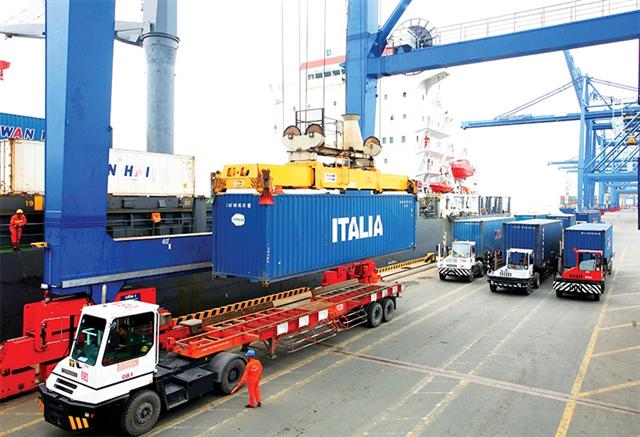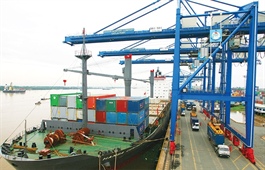Exporters strike gold by unlocking new markets
Exporters strike gold by unlocking new markets
Amid the Vietnamese government’s efforts in deploying economic diplomatic efforts, the prolonged blow of the health crisis sabotaging import and export activities has prompted enterprises to seek new means of expanding the markets for their products and services.

Exporters from Vietnam and other countries are urged to look for new markets to ramp up business again, Photo Le Toan
|
In its latest forecast a few weeks ago, the International Monetary Fund (IMF) warned that global economic growth for 2020 may drop 4.9 per cent, worse than the projection it released in April.
Other big economies are also predicted by the IMF to suffer from negative economic growth this year, such as the US (-8 per cent) and the EU (-10.2 per cent), while China is expected to grow only 1 per cent.
Meanwhile, the World Bank has just forecast that the global economy will decrease 5.2 per cent this year, when gloom-ridden growth may also hit developed economies (-7 per cent), and emerging and developing economies (-3 per cent).
The World Trade Organization predicted that global trade will decline 13-32 per cent on-year, depending on COVID-19 developments while the World Bank and the IMF projected the rate to drop 11.9-13.4 per cent this year, respectively.
“These unfavourable conditions, in addition to the pandemic’s resurge in Vietnam will dampen the country’s export-import activities and economic recovery,” stated Deputy Minister of Industry and Trade Cao Quoc Hung.
Solutions for businesses
The past three months have witnessed Vietnamese authorities busy with working out methods for the country to attract more foreign investment and expand trade with foreign countries and territories, especially in the context that Vietnam is entering a new normalcy, with local production beginning to bounce back and enterprises in critical need of boosting exports overseas.
Over a week ago, Prime Minister Nguyen Xuan Phuc held talks with Japanese counterpart Shinzo Abe. This was the second batch of talks within three months between the two leaders, with one of the focuses laid on expanding both countries’ trade and investment relationship backed by bilateral agreements including the Vietnam-Japan Economic Partnership Agreement and the Comprehensive and Progressive Agreement for Trans-Pacific Partnership.
The EU-Vietnam Free Trade Agreement also comes into play, with Japanese companies seeking to boost export-oriented investments in Vietnam and then export products to the European Union.
The two nations’ two-way trade hit $40 billion last year and $22.1 billion in the first seven months, including $10.9 billion earned by Vietnam from exporting to Japan, down 5 per cent on-year.
The two prime ministers agreed that both nations could soon resume commercial flights, helping swell trade ties. PM Abe said some big Japanese investors are receiving support from the Japanese government to expand their supply chains and half of them have selected Vietnam to boost investment. PM Phuc said he will soon have a meeting with Japanese investors.
Last month, Deputy Prime Minister and Minister of Foreign Affairs Pham Binh Minh also had talks with South Korea’s Minister of Foreign Affairs Kang Kyung Wha, announcing that Vietnam is considering the resumption of commercial flights with some nations including South Korea, with the aim of upping trade and investment ties.
According to the Ministry of Foreign Affairs, Vietnamese leaders are expected to have telephone discussions with leaders of many nations and markets to beef up trade and investment ties. Talks have already been carried out with Russia, Canada, the United States, Kuwait, China, and the EU.
Vietnam’s Ministry of Industry and Trade (MoIT) said that the ongoing COVID-19 outbreaks may make it hard for Vietnam to reach its initial export-import targets.
The National Assembly last year set the target of a 7-8 per cent rise in export turnover for 2020, with a trade deficit of under 2 per cent of total export turnover.
In 2019, total export turnover hit $253.5 billion. This means that in 2020, total export turnover will be $281.9-284.5 billion, and total import turnover will be $287.5-290.2 billion, with a trade deficit of $5.63-5.69 billion. In total, the export-import revenue for 2020 will be $569.4-574.7 billion, far higher than last year’s $517 billion.
“However, the targets may not be easy to reach. Difficulties can now be seen in almost all sectors,” said Nguyen Bich Lam, former head of the General Statistics Office.
Saving themselves
Over the past three months, Joo Hye Sook, sales representative of Hoan Anh Trade Co., Ltd. in Hanoi, has been working hard to help her company, a Vietnam-South Korea joint venture trading in industrial equipment and electronics, out of difficulties. The company exports products to South Korea, Japan, and some European nations.
“Many of the European markets have still been closed, so we must increase the exploration of new partners in South Korea and Japan, and some Southeast Asian nations like Malaysia and Thailand,” Sook said. “A big sum of money has been spent on marketing activities. We are also boosting marketing online, with initial positive results.”
Hong Sun, vice chairman of the Korea Chamber of Business in Vietnam (KorCham), told VIR that about 20-30 per cent of over 9,000 South Korean businesses in Vietnam currently have to seek new markets, both in Vietnam and overseas. “Not only big businesses, but also many other smaller ones in all sectors, from industry, garment and textiles, and services, are also facing great woes in seeking markets,” he said. “Their outlets have significantly reduced.”
The MoIT reported that in the first seven months of 2020, Vietnam’s garment and textile sector earned an export turnover of $16.2 billion, down 12.1 per cent on-year.
It is expected that in the second half of the year, the sector will suffer a 14-18 per cent decline in export turnover, with total export turnover for the whole year forecast to be $32.75 billion, down 16 per cent on-year.
Elsewhere, Nguyen Viet Thang, head of the Planning Division of X29 JSC, told VIR that his company exports wood, and garment and textile products to China, and is now planning to boost exports to Japan and South Korea, also its traditional markets. “Almost no goods container has been exported to China since late January, and we are working with new partners from Southeast Asia, Japan, South Korea, and Europe to sell goods,” Thang said.
X29 also imports many types of materials from China, and is hunting for new sources from Bangladesh, South Korea, and India.
In another case, Minh Ngoc Equipment and Trade Ltd. in Hanoi has been unable to export any of its containers of cotton buds and shavers to China, a market creating 40 per cent of the company’s export turnover. “We are working with some new partners from South Korea and Japan to boost exports and offset the losses from exports to China,” said vice director Nguyen Thi Tuat.
According to the Ministry of Planning and Investment’s Department of Enterprise Development, hundreds of thousands of businesses in Vietnam suffering from woes caused by COVID-19 are advised to find new markets to export their products.
According to Sun of KorCham, many South Korean companies are also finding it difficult to expand to new markets due to various hurdles. “One of the obstructions is that new partners must be reliable, while nothing shows that they are. Thus, it can take time before new contracts are signed, and much money must be spent on studying and surveying markets.”
|
Who has been the most economically affected by the pandemic? Beyond the macroeconomic impact of COVID-19, the pandemic has affected many businesses and individuals in Vietnam. If almost everyone has been affected at one point in time, it seems that the negative effects have been generally temporary due to the rebound of the domestic economy since the end of April. Most family businesses – which account for the vast majority of firms operating in Vietnam – lost money during the lockdown but were able to recover quickly because of their accumulated savings, operating flexibility, and resilience. However, the impact of COVID-19 on businesses and workers varies greatly across sectors and locations. According to the Ministry of Labour, Invalids and Social Affairs, approximately eight million Vietnamese workers have lost their jobs at one point in time in the last few months, while another 17 million had to cut their working hours or income. The urban unemployment rate also jumped by 33 per cent in the last few months, reaching almost 4.5 per cent at the end of the second quarter, and the number of business closures reached almost 30,000 between January and June, which is one-third higher than recorded a year ago. Concurrently, the government estimates that the average monthly revenue by worker declined by about 5 per cent between the second quarter of 2019 and the same period in 2020, with a proportionally bigger impact on services (-7.3 per cent) and industries (-5.1 per cent) than on agriculture (-2.9 per cent). Source: World Bank |

























